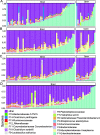The vaginal and fecal microbiomes are related to pregnancy status in beef heifers
- PMID: 31857897
- PMCID: PMC6909518
- DOI: 10.1186/s40104-019-0401-2
The vaginal and fecal microbiomes are related to pregnancy status in beef heifers
Abstract
Background: The greatest impact on profitability of a commercial beef operation is reproduction. However, in beef heifers, little is known about the vaginal and fecal microbiota with respect to their relationship with fertility. To this end, we followed heifers through gestation to examine the dynamics of vaginal and fecal microbial composition throughout pregnancy.
Results: Heifers were exposed to an estrus synchronization protocol, observed over a 12-day period, artificially inseminated 12 h to 18 h after observed estrus, and subsequently exposed to bulls for a 50-day breeding season. Vaginal samples were taken at pre-breeding (n = 72), during the first (n = 72), and second trimester (n = 72) for all individuals, and third trimester for individuals with confirmed pregnancies (n = 56). Fecal samples were taken at pre-breeding (n = 32) and during the first trimester (n = 32), including bred and open individuals. Next generation sequencing of the V4 region of the16S rRNA gene via the Illumina MiSeq platform was applied to all samples. Shannon indices and the number of observed bacterial features were the same in fecal samples. However, significant differences in vaginal microbiome diversity between gestation stages were observed. No differences in beta-diversity were detected in vaginal or fecal samples regarding pregnancy status, but such differences were seen with fecal microbiome over time. Random Forest was developed to identify predictors of pregnancy status in vaginal (e.g., Histophilus, Clostridiaceae, Campylobacter) and fecal (e.g., Bacteroidales, Dorea) samples.
Conclusions: Our study shows that bovine vaginal and fecal microbiome could be used as biomarkers of bovine reproduction. Further experiments are needed to validate these biomarkers and to examine their roles in a female's ability to establish pregnancy.
Keywords: Beef cattle; Pregnancy; Random forest; Reproduction; Vaginal microbiome.
© The Author(s). 2019.
Conflict of interest statement
Competing interestsThe authors declare that they have no competing interests.
Figures






Similar articles
-
Vaginal bacterial community composition and concentrations of estradiol at the time of artificial insemination in Brangus heifers.J Anim Sci. 2020 Jun 1;98(6):skaa178. doi: 10.1093/jas/skaa178. J Anim Sci. 2020. PMID: 32515480 Free PMC article.
-
Effect of reproductive tract scoring on reproductive efficiency in beef heifers bred by timed insemination and natural service versus only natural service.Theriogenology. 2014 Apr 15;81(7):918-24. doi: 10.1016/j.theriogenology.2014.01.008. Epub 2014 Jan 21. Theriogenology. 2014. PMID: 24560451
-
Effects of dietary restriction and one-carbon metabolite supplementation during the first 63 days of gestation on the maternal gut, vaginal, and blood microbiota in cattle.Anim Microbiome. 2024 Aug 29;6(1):48. doi: 10.1186/s42523-024-00335-2. Anim Microbiome. 2024. PMID: 39210404 Free PMC article.
-
Timed artificial insemination strategies with or without short-term natural service and pregnancy success in beef heifers.Theriogenology. 2021 May;166:97-103. doi: 10.1016/j.theriogenology.2021.02.023. Epub 2021 Mar 3. Theriogenology. 2021. PMID: 33721682
-
Dystocia in beef heifers: a review of genetic and nutritional influences.N Z Vet J. 2006 Dec;54(6):256-64. doi: 10.1080/00480169.2006.36708. N Z Vet J. 2006. PMID: 17151722 Review.
Cited by
-
Role of Genital Tract Bacteria in Promoting Endometrial Health in Cattle.Microorganisms. 2022 Nov 12;10(11):2238. doi: 10.3390/microorganisms10112238. Microorganisms. 2022. PMID: 36422307 Free PMC article.
-
A Review of the Diversity of the Genital Tract Microbiome and Implications for Fertility of Cattle.Animals (Basel). 2022 Feb 13;12(4):460. doi: 10.3390/ani12040460. Animals (Basel). 2022. PMID: 35203168 Free PMC article. Review.
-
Maternal Fecal Microbes Contribute to Shaping the Early Life Assembly of the Intestinal Microbiota of Co-inhabiting Yak and Cattle Calves.Front Microbiol. 2022 Jun 6;13:916735. doi: 10.3389/fmicb.2022.916735. eCollection 2022. Front Microbiol. 2022. PMID: 35733965 Free PMC article.
-
Exploring the microbiome of two uterine sites in cows.Sci Rep. 2023 Oct 31;13(1):18768. doi: 10.1038/s41598-023-46093-0. Sci Rep. 2023. PMID: 37907617 Free PMC article.
-
Exploration and comparison of bacterial communities present in bovine faeces, milk and blood using 16S rRNA metagenomic sequencing.PLoS One. 2022 Aug 31;17(8):e0273799. doi: 10.1371/journal.pone.0273799. eCollection 2022. PLoS One. 2022. PMID: 36044481 Free PMC article.
References
-
- Hess B, Lake S, Scholljegerdes E, Weston T, Nayigihugu V, Molle J, et al. Nutritional controls of beef cow reproduction. J Anim Sci. 2005;83:E90–E106.
-
- Bellows D, Ott S, Bellows R. Cost of reproductive diseases and conditions in Cattle1. Prof Anim Sci. 2002;18:26–32. doi: 10.15232/S1080-7446(15)31480-7. - DOI
-
- Lamb GC, Mercadante VRG, Henry DD, Fontes PLP, Dahlen CR, Larson JE, et al. Invited review : advantages of current and future reproductive technologies for beef cattle production. Prof Anim Sci. 2016;32:162–171. doi: 10.15232/pas.2015-01455. - DOI
-
- Dziuk P, Bellows R. Management of reproduction of beef cattle, sheep and pigs. J Anim Sci. 1983;57:355–379. doi: 10.2527/jas1983.572355x. - DOI
LinkOut - more resources
Full Text Sources

